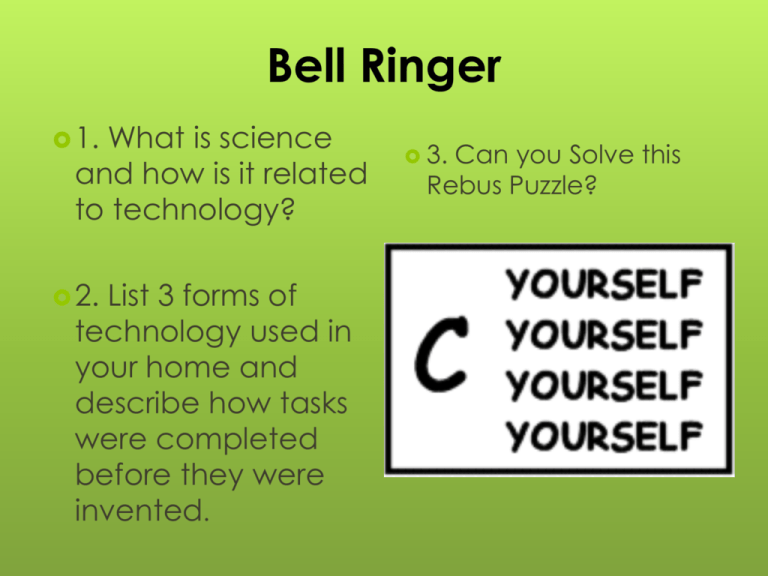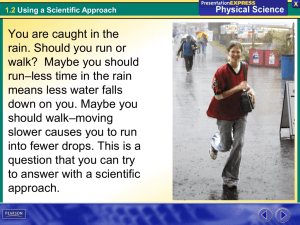Scientific Methods - Madison County Schools
advertisement

Bell Ringer 1. What is science and how is it related to technology? 2. List 3 forms of technology used in your home and describe how tasks were completed before they were invented. 3. Can you Solve this Rebus Puzzle? Scientific Method/Exp Design What How is science? are science and technology related? Science and Technology Science is a system of knowledge and the methods you use to find that knowledge. The goal of science is to expand knowledge. Technology is the use of knowledge to solve practical problems. The goal of technology is to apply knowledge. Scientific Methods What is the scientific method? What is the goal of a scientific method? Scientific Methods Scientific Method - An organized plan for gathering, organizing, and communicating information. The goal of any scientific method is to solve a problem or to better understand an observed event. Scientific Methods Making Observations • Scientific investigations often begin with observations. • observation is information that you obtain through your senses. Scientific Methods Question based on Observation: • Why does this happen? • How does this happen? Scientific Methods Forming a Hypothesis A hypothesis is a proposed measureable answer to a question. - Stated in an “If…. then…” format. Scientific Methods Testing a Hypothesis In an experiment, any factor that can change is called a variable. • The independent variable causes a change. • • The dependent variable changes in response to the independent variable. (What you are measuring!) • • X-axis of Graph Y-axis of Graph A controlled experiment is an experiment in which only one variable, the independent variable, is deliberately changed at a time. Scientific Methods Testing a Hypothesis Procedures Must be specific - detailed! Another scientist must be able to repeat your exact process and collect similar results. Written as commands Scientific Methods Drawing Conclusions A conclusion describes how facts apply to a hypothesis. Scientific Methods Drawing Conclusions A conclusion describes how facts apply to a hypothesis. Scientific Methods Once is not enough to prove validity! Scientific Methods Developing a Theory A scientific theory is a well-tested explanation for a set of observations or experimental results. Scientific Methods Question: How does speed affect how wet you get in the rain? Hypothesis: The faster your speed, the drier you will stay. Experiment: Test whether speed affects how wet you get in the rain. Scientific Methods In 1997, two meteorologists conducted a controlled experiment to determine if moving faster keeps you drier in the rain. One scientist walked 100 yards and the other ran the same distance. Variables, such as type of clothes, were controlled. Scientific Methods The clothes of the walking scientist accumulated 217 grams of water; the clothes of the running scientist accumulated 130 grams of water. Draw a Conclusion: The scientists concluded that running in the rain keeps you drier. Scientific Laws How does a scientific law differ from a scientific theory? Scientific Laws After repeated observations or experiments, scientists may arrive at a scientific law. • A scientific law is a statement that summarizes a pattern found in nature. Newton’s law of gravity is a scientific law that has been verified over and over. Scientists have yet to agree on a theory that explains how gravity works. Scientific Laws A scientific law describes an observed pattern in nature without attempting to explain it. The explanation of such a pattern is provided by a scientific theory. Scientific Models Why are scientific models useful? Scientific Models Why are scientific models useful? A model is a representation of an object or event. A street map is a model of a city. Scientific Models Why are scientific models useful? A model is a representation of an object or event. A street map is a model of a city. Scientific models make it easier to understand things that might be too difficult to observe directly. Assessment Questions 1. What is a hypothesis? a. b. c. d. a statement that summarizes a pattern found in nature a well-tested explanation for a set of observations or experimental results an experiment in which only one variable is deliberately changed at a time a proposed answer to a question Assessment Questions 1. What is a hypothesis? a. b. c. d. a statement that summarizes a pattern found in nature a well-tested explanation for a set of observations or experimental results an experiment in which only one variable is deliberately changed at a time a proposed answer to a question ANS: D Assessment Questions 2. How does a scientific law differ from a theory? a. b. c. d. A scientific law describes observations while a theory provides an explanation. A scientific law cannot be changed by additional observations, but a theory can be changed. A theory is a possible explanation, but a scientific law is a proven explanation. There is no difference because scientific law and theory are two terms that mean the same thing. Assessment Questions 2. How does a scientific law differ from a theory? a. b. c. d. A scientific law describes observations while a theory provides an explanation. A scientific law cannot be changed by additional observations, but a theory can be changed. A theory is a possible explanation, but a scientific law is a proven explanation. There is no difference because scientific law and theory are two terms that mean the same thing. ANS: A Assessment Questions 3. What is the main purpose of a scientific model? a. b. c. d. to show how a hypothesis was developed to prove a theory to make complex concepts easier to understand to show a large object, such as the Earth, in a smaller form Assessment Questions 3. What is the main purpose of a scientific model? a. b. c. d. to show how a hypothesis was developed to prove a theory to make complex concepts easier to understand to show a large object, such as the Earth, in a smaller form ANS: C







